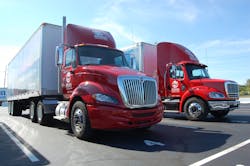A three-way strategic alliance between Allison Transmission Holdings Inc., Dana Holding Corp., and Fallbrook Technologies Inc., will seek to bring a new continuously variable transmission (CVT) to the trucking market before the end of this decade – a transmission designed to boost fuel economy and vehicle efficiency while significantly reducing weight.
In a conference call with reporters, Lawrence Dewey – Allison’s chairman, president and CEO – and Roger Wood – president and CEO of Dana – said their respective companies recently signed a letter of intent to jointly manufacture transmissions for trucking and other markets based on licenses purchased from Fallbrook to use its NuVinci CVT design.
“We’re exploring exclusively producing transmission components under this agreement,” Dana’s Wood said. “We expect it will take two to three years to optimize the technology and then ramp up to full scale manufacturing. We think we can have an off-road CVT model ready in the next three to five years, with a passenger car CVT ready by the end of the decade.”
Allison’s Dewey added that a version of the CVT based on Fallbrook’s design for medium and heavy trucks should be ready at some point within that three to eight year timeframe.
William Klehm III, chairman and CEO of Fallbrook, noted on the call that it took the last eight years to validate and develop its NuVinci CVT and he expects a working prototype designed for trucks could be ready anywhere in the next 12 to 24 months.
He explained that the key to Fallbrook’s NuVinci CVT template is the use of what he called “balls and discs” to replace the gears used in a traditional transmission. Tilting the balls changes their contact diameters and varies the speed ratio, thus providing what Klehm calls “an unlimited number of gear ratios” to optimize engine efficiency, thus improving fuel economy.
“It also means the transmission is less complex, scales and packages more easily, and costs less to manufacture – all while achieving optimum performance,” he noted.
The monetary investments by Allison and Dana for the Fallbrook licenses and engineering validation were not disclosed on the call, as Allison’s Dewey said they “did not meet U.S. reporting requirements,” though he stressed manufacturing, tooling, and prototype costs may be revealed in the future.
Pricing for the new CVT model is also being kept close to vest and will largely be dependent on the durability and performance characteristics displayed during prototype development and testing.
“Long terms durability, performance of the powertrain, and overall capability will determine customer acceptance,” Dewey told Fleet Owner – adding that he expects this new CVT technology to deliver “significant” fuel economy improvements to the trucking market by both improving engine efficiency and reducing weight.
Those are key metrics that will also help the industry comply with the second and more stringent round of greenhouse gas (GHG) emission regulations scheduled for implementation over the next 10 years, he said.
“Of course, any fuel economy improvements are going to be duty-cycle dependent,” Dewey stressed. “But the important thing here is that we’re not working on core technology development [with the new CVT] here – from this point on it’s really all about application engineering.”
About the Author
Sean Kilcarr
Editor in Chief
Sean Kilcarr is a former longtime FleetOwner senior editor who wrote for the publication from 2000 to 2018. He served as editor-in-chief from 2017 to 2018.
